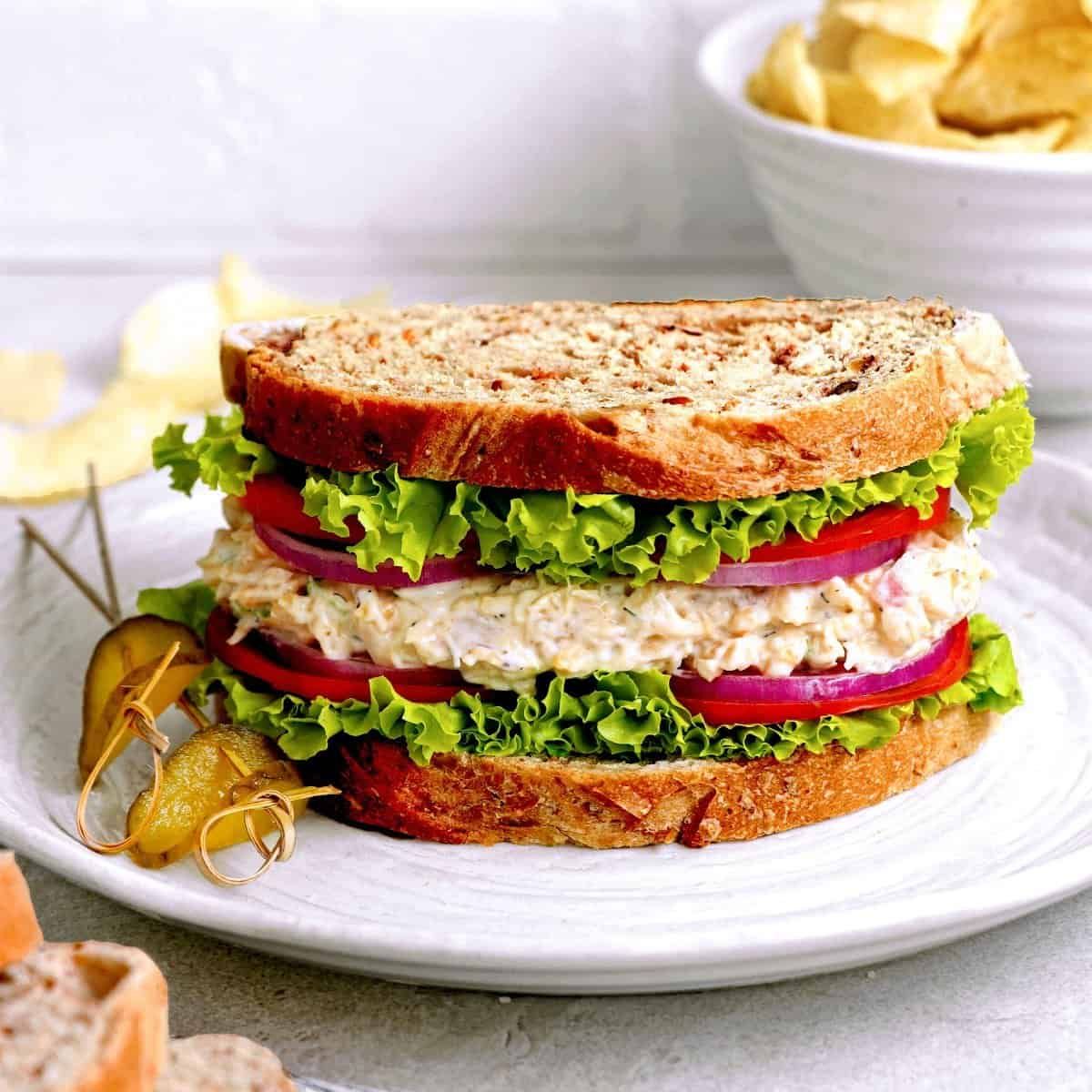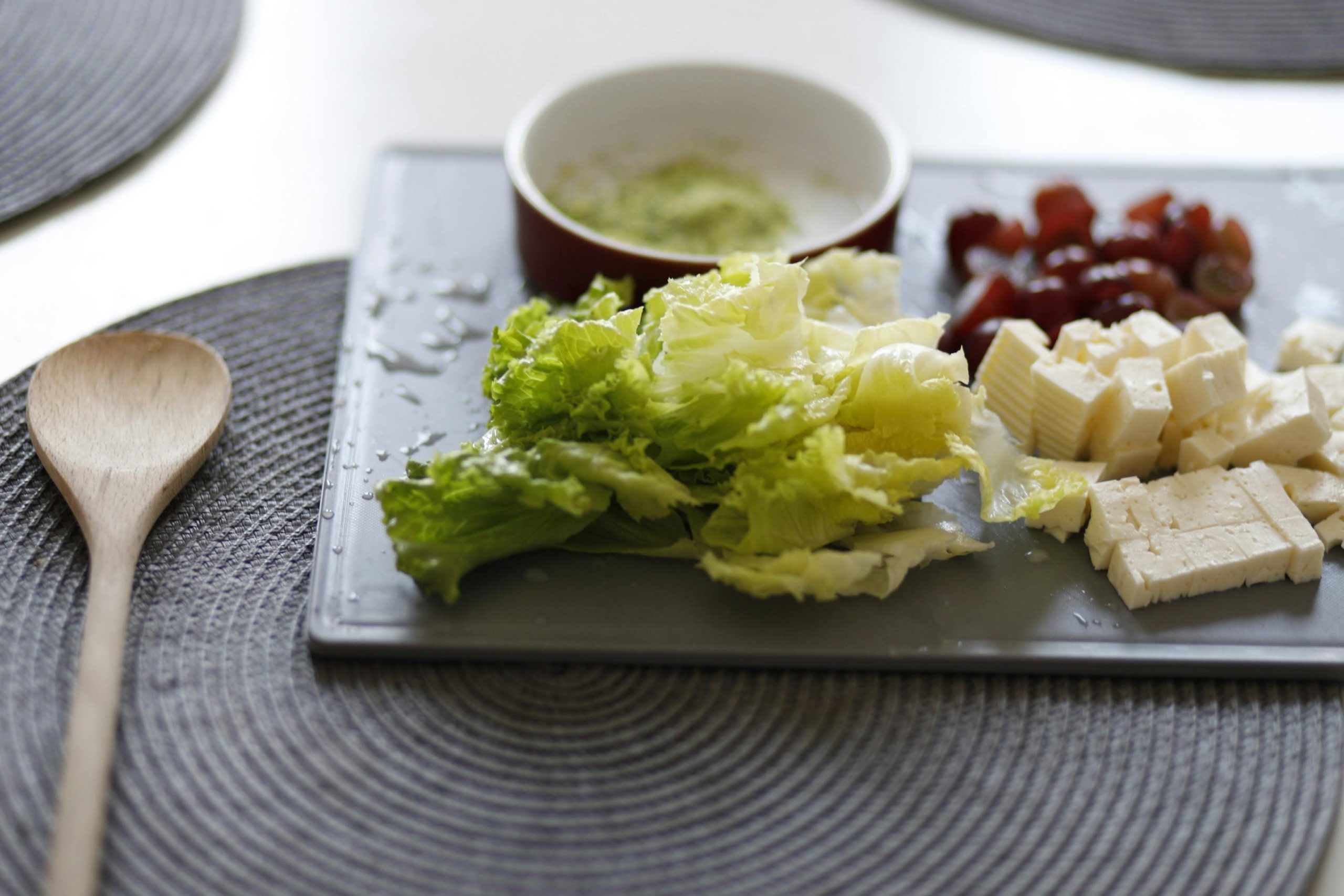Have you ever wondered how to enjoy the classic taste of tuna without the fish?
Many people miss the familiar flavors of seafood when they switch to a plant-based diet.
Vegan tuna, primarily made from mashed chickpeas, nori, and a blend of flavorful ingredients like vegan mayo and lemon juice, offers a delightful alternative that mimics the taste and texture of traditional tuna.
In this comprehensive guide, we’ll explore the essential ingredients, various recipes, and the best ways to serve and store vegan tuna, ensuring you can savor this plant-based delight in your meals.
Essential Ingredients for Crafting Vegan Tuna Fish

Crafting a convincing vegan tuna fish requires a thoughtful blend of ingredients that mimic the texture and flavor of traditional tuna. At the core of most vegan tuna recipes are chickpeas, which are mashed to create a flaky texture reminiscent of canned tuna. Nori sheets are also crucial, as they impart a subtle sea-like flavor that enhances the fishiness without using any animal products. These ingredients are not only effective in recreating the desired taste and texture but are also packed with nutrients, making them a healthy choice for any meal.
To achieve the creamy and tangy profile typical of tuna salad, vegan mayonnaise and lemon juice are added. Ingredients like dijon mustard and nutritional yeast play significant roles in adding depth and a touch of umami, which is essential for that savory flavor. Additionally, capers and pickles can be included to introduce brininess and crunch, enhancing the overall sensory experience of the vegan tuna. Each ingredient is selected not only for its flavor but also for its ability to contribute to the overall nutritional profile, including plant-based proteins and essential vitamins.
Substitutions for Customizing Your Vegan Tuna Recipe
When customizing your vegan tuna recipe to accommodate various dietary needs or flavor preferences, consider these easy substitutions. For a soy-free version, replace soy sauce with coconut aminos. If you’re avoiding nuts, ensure your vegan mayo is nut-free or use hummus as a creamy binder instead. For those who prefer not to use seaweed, try a dash of Old Bay Seasoning for a different kind of oceanic flavor. These substitutions help make your vegan tuna accessible to everyone, regardless of dietary restrictions.
Creative Variations of Vegan Tuna to Try

For those looking to spice up their vegan tuna, adding jalapeños or a sprinkle of cayenne pepper can introduce a delightful kick. Another creative variation is the Mediterranean-inspired version where you mix in sun-dried tomatoes, olives, and a pinch of oregano to transport your taste buds to southern Europe. These additions not only diversify the flavors but also enhance the nutritional value with antioxidants and healthy fats.
If you’re a fan of Asian flavors, consider creating a sushi-style vegan tuna. Mix in wasabi or ginger, and wrap the mixture in nori sheets before slicing it into sushi-sized bites. Alternatively, for a hearty meal, combine your vegan tuna with avocado and cilantro, then serve it as a filling for tacos or burritos. These variations showcase the versatility of vegan tuna, making it a suitable base for a wide range of culinary experiments.
How to Prepare Vegan Tuna: A Step-by-Step Guide

Preparing vegan tuna is a straightforward process that can bring the ocean’s flavors to your kitchen without any fish. Start by draining and rinsing a can of chickpeas. Place them in a bowl and use a fork or a potato masher to break them down until they achieve a flaky texture, similar to traditional canned tuna. This step is crucial as it sets the base for your vegan tuna.
Next, enhance the flavor by adding finely chopped nori sheets, which give that distinct seafood taste. Mix in vegan mayonnaise, a squeeze of lemon juice, a sprinkle of garlic powder, and a dash of soy sauce for depth. For a tangy twist, include a teaspoon of dijon mustard and a bit of apple cider vinegar. Season with salt and black pepper to taste. Combine all ingredients well to ensure each bite is flavorful and satisfying.
Expert Tips for Perfecting Your Vegan Tuna
To elevate your vegan tuna, start by ensuring you drain and rinse the chickpeas thoroughly to avoid a mushy texture. When mashing the chickpeas, use a fork rather than a food processor to maintain some chunkiness, mimicking the texture of traditional tuna. This method provides a more satisfying mouthfeel and prevents the mixture from becoming too pasty.
For an exceptional flavor, do a taste test before finalizing the mix. Adjust the seasonings according to your preference—more lemon juice for tartness, a bit more dijon mustard for piquancy, or additional salt and pepper. If time allows, let the mixture chill in the refrigerator for at least 30 minutes; this helps the flavors meld together beautifully. Remember, the key to perfect vegan tuna is in the balance of textures and flavors.
Watch and Learn: Vegan Tuna Preparation Video
For those who prefer visual learning, watching a video on vegan tuna preparation can be incredibly helpful. These videos often provide step-by-step instructions and practical tips, showing exactly how to achieve the perfect texture and flavor. They typically cover everything from the initial mashing of chickpeas to the final seasoning adjustments, making it easy to follow along and replicate the recipe at home.
Best Ways to Serve Vegan Tuna

Vegan tuna, a delightful plant-based alternative to traditional tuna, can be served in a variety of delicious ways that cater to different tastes and occasions. For a quick and easy meal, try spreading a generous amount of vegan tuna on slices of your favorite bread, topped with crisp lettuce and fresh tomato slices for a classic tuna salad sandwich experience. This not only provides a satisfying meal but also packs a nutritional punch with the combination of protein-rich chickpeas and fiber from fresh vegetables.
If you’re looking to entertain or enjoy a light, healthy snack, serving vegan tuna on crackers or stuffed into lettuce wraps can make for elegant and refreshing options. These servings are perfect for parties or as a nutritious snack between meals. For those who enjoy a bit of creativity in their meals, vegan tuna can also be used as a filling for tuna melts by adding vegan cheese and broiling until bubbly and golden brown. Each of these serving suggestions ensures that you can enjoy vegan tuna in a way that fits your lifestyle and dietary preferences.
Crafting the Perfect Vegan Tuna Salad
Crafting the perfect vegan tuna salad involves combining finely mashed chickpeas with ingredients that add crunch and flavor, such as diced celery and cucumber. To elevate the taste, mix in vegan mayonnaise and a squeeze of fresh lemon juice for creaminess and a tangy zest. For a hint of the sea, include finely chopped nori or dulse flakes. This salad can be served on a bed of greens, as a filling for a hearty tuna salad sandwich, or scooped onto crackers for a delightful snack. Each bite offers a burst of flavors, making it a satisfying dish that’s both nutritious and easy to prepare.
Storing Vegan Tuna for Freshness and Longevity
To ensure your vegan tuna remains fresh and tasty, storing it properly is crucial. Refrigeration is the best method for short-term storage. Place the vegan tuna in an airtight container to prevent it from absorbing odors from other foods in the fridge. This method will keep your vegan tuna fresh for up to three days. For optimal freshness, make sure your refrigerator’s temperature is set below 40°F (4°C).
For longer storage, freezing is an effective option. Vegan tuna can be frozen for up to three months without losing much of its texture or flavor. To freeze, portion the vegan tuna into meal-sized servings and store each portion in a freezer-safe airtight container or heavy-duty freezer bags. Thaw overnight in the refrigerator when ready to use, and give it a good stir to redistribute any moisture before serving.
Discover Vegan Delicacies with Indulge‘s Culinary Tours
INDULGE‘s culinary tours in Zurich are not just about tasting food; they are immersive experiences that deepen your appreciation for vegan cuisine, including dishes like vegan tuna fish. These tours, led by knowledgeable local chefs, provide a unique opportunity to explore how traditional dishes are reinvented with plant-based ingredients. Participants gain firsthand experience in how vegan alternatives, such as vegan tuna, can be as delightful and satisfying as their traditional counterparts.
During these tours, you’ll also learn about the ingredients and techniques used in creating vegan delicacies. Here are some highlights:
- Understanding the use of nori and chickpeas to mimic the texture and flavor of tuna.
- Discovering the role of vegan mayo and lemon juice in enhancing the creaminess and tanginess of dishes.
These insights, combined with the stories behind Zurich’s vibrant culinary scene, make INDULGE‘s tours a must-try for anyone curious about plant-based cooking.
Frequently Asked Questions
What is vegan tuna made of?
Vegan tuna is primarily made from mashed chickpeas, nori sheets, vegan mayonnaise, and lemon juice. These ingredients are combined to mimic the texture and flavor of traditional tuna.
Is vegan tuna healthy?
Yes, vegan tuna is healthy. It is made with ingredients like chickpeas and nori sheets which are packed with nutrients, providing plant-based proteins and essential vitamins. Ingredients such as vegan mayonnaise, lemon juice, and nutritional yeast add depth and a touch of umami, contributing to both the flavor and nutritional profile.
What do vegans eat instead of tuna?
Vegans can eat a plant-based alternative known as vegan tuna instead of traditional tuna. This alternative is crafted from ingredients like mashed chickpeas, nori sheets, vegan mayonnaise, and lemon juice to recreate the taste and texture of tuna.
What is mock tuna made of?
Mock tuna, similar to vegan tuna, is typically made from ingredients such as mashed chickpeas, nori sheets, vegan mayonnaise, and lemon juice. These components are used to mimic the flaky texture and seafood-like flavor of traditional tuna.







